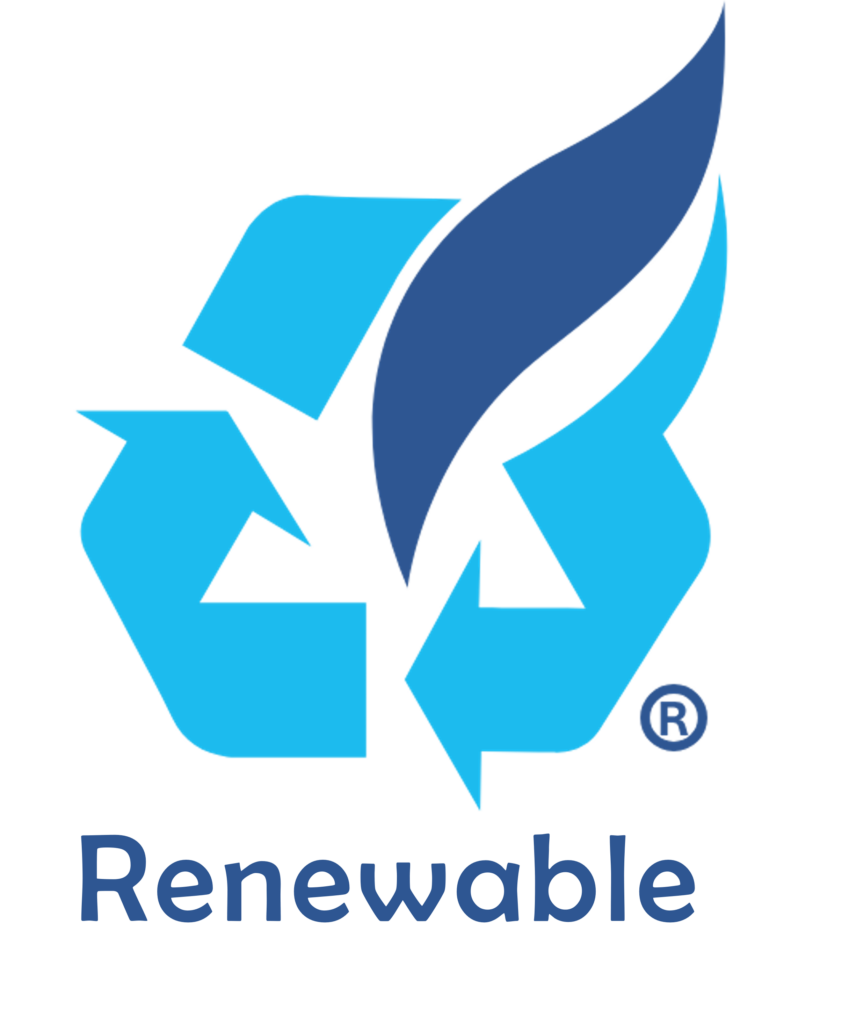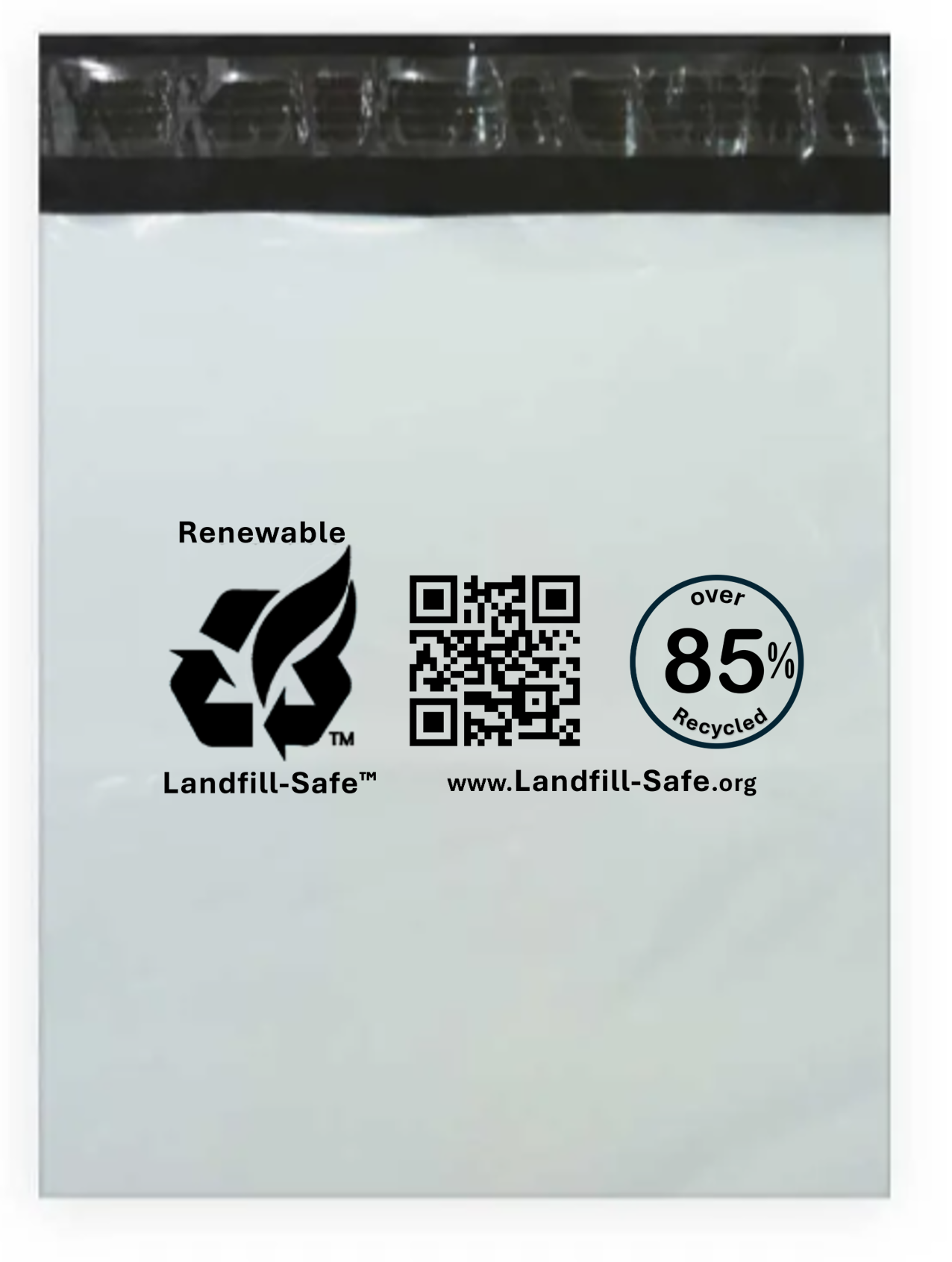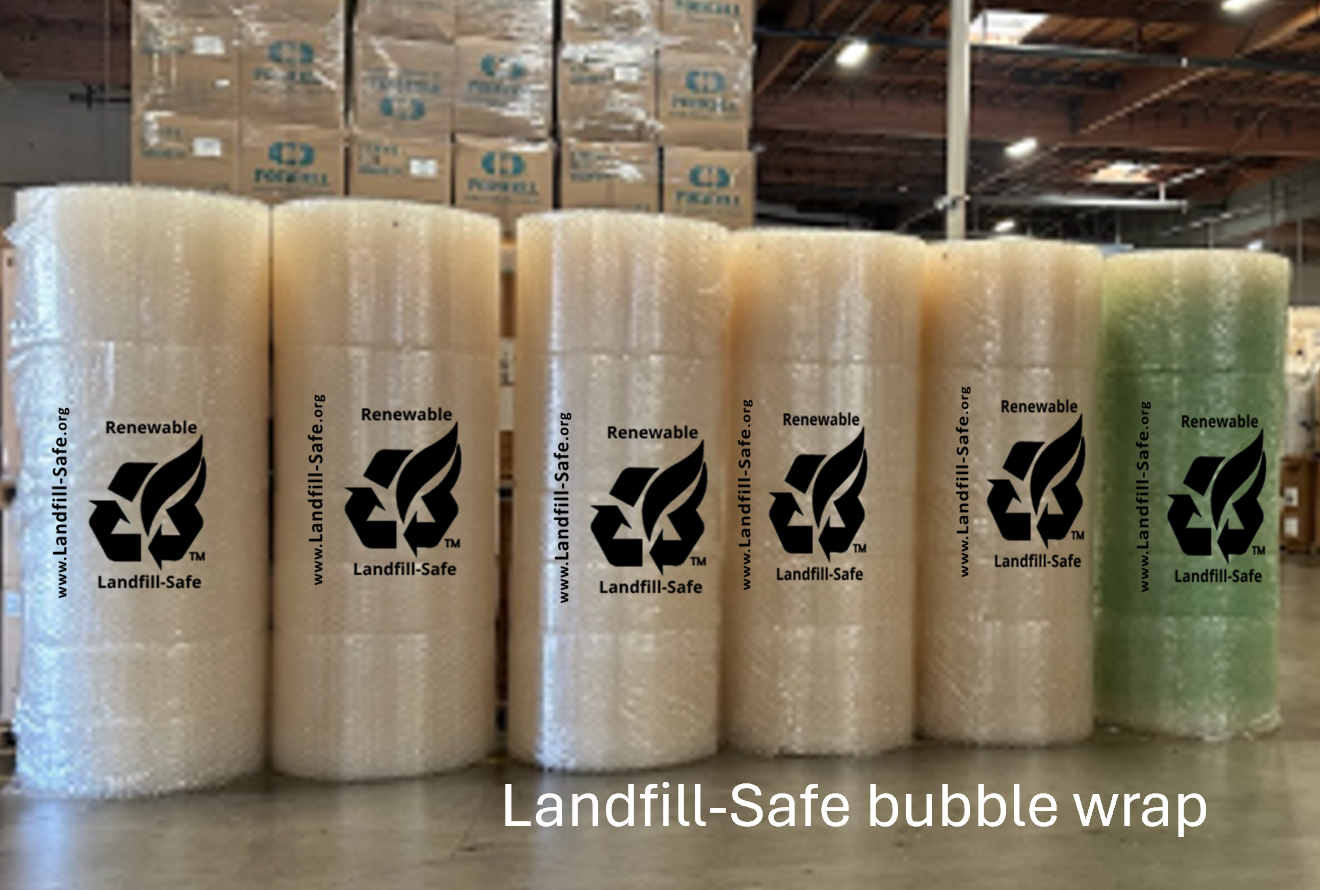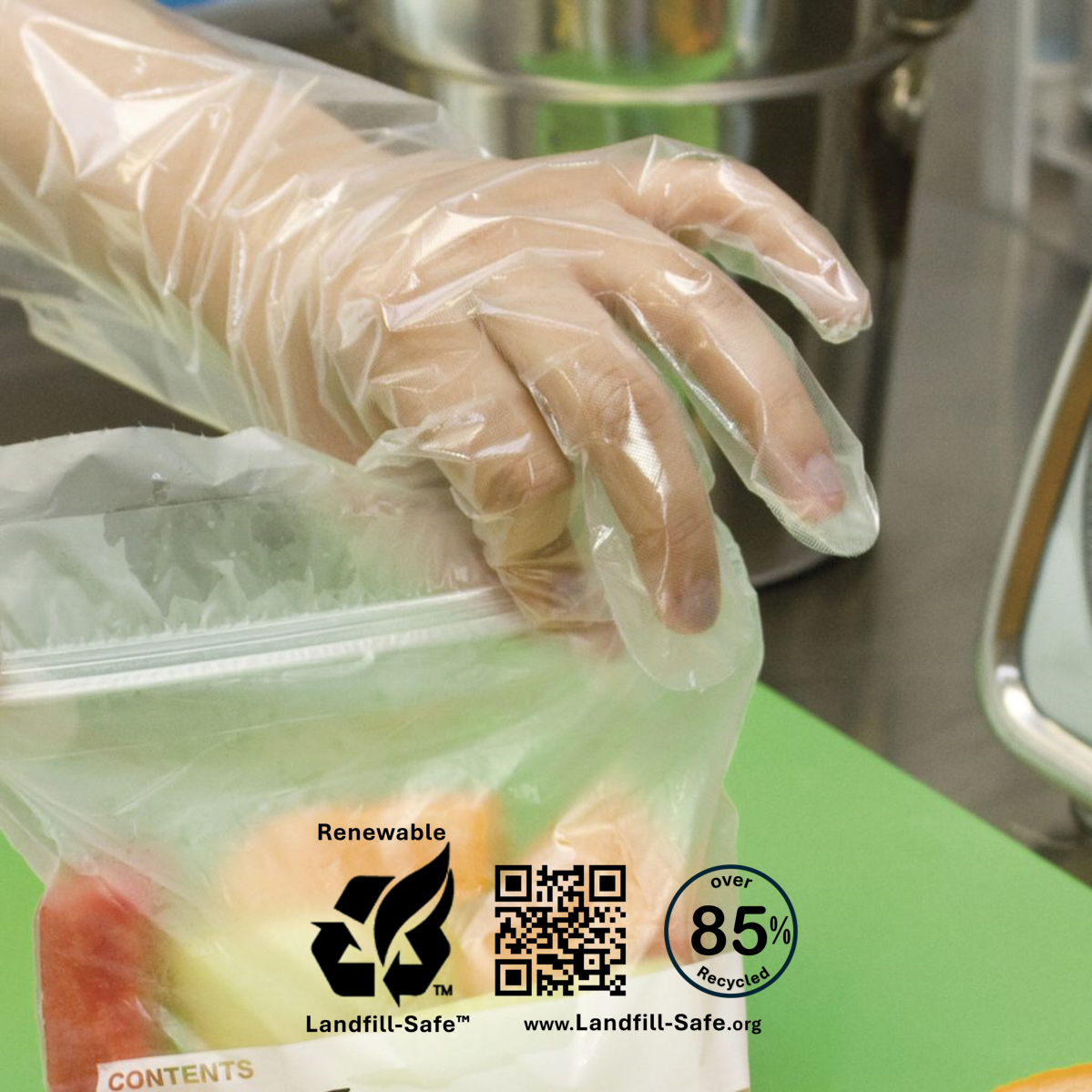Landfill-Safe Plastic Products Have Arrived
With confidence, consumers can use Landfill-Safe products from these leading suppliers knowing they will be fully recycled in EPA regulated landfill recovery centers now serving about 90% of North America’s population.
All you need to do is throw it in the trash. No sorting required. Makes no difference if contaminated.
• FDA approved, Prop. 65, SB 343, SB 54, and FTC compliant •

Landfill-Safe vs. Biodegradable & Compostable
The word “biodegradable” is well-intentioned with plastic packaging, but the ugly truth is the FTC and the state of California (SB 343) say it cannot be used on most single-use products marked as “recyclable” or “compostable”.
- More than 90% of plastics marked with the chasing arrow logos are not recyclable.
- Less than 1% of compostable plastics are ever composted.
Unfortunately, these products go to landfills, biodegrade, and release GhG into the atmosphere.
On the other hand, at least 85% of Landfill-Safe plastics are renewed / recycled helping mitigate global warming!
Landfill-Safe Verification
The Landfill-Safe logo provides trustworthy assurance a plastic material meets EPA regulated landfill requirements (LMOP). It verifies third-party ASTM standards for plastic products that are renewed in North American landfills.
For every company wishing to make “landfill-safe” claims on their products and packaging, this is their first step.
Should you wish to learn more about the Landfill-Safe technology, visit RNG Plastics and contact the experts.

Here's What the Experts Are Saying
- “It’s the holy grail of plastics” – Dr. Joe Greene, PhD
- “Why didn’t they think of this in the first place?” – John Smith, MS Recycling
- “[RNG Plastics] are revolutionary!” – Founder/president of a large bioplastics company.
- “This is the most important plastic innovation of the 21st century!” – Steve Evanter
- “We at RNG Plastics are inspired to create renewable, Landfill-Safe plastics for centuries to come!” – Bob DeMatteis
What really happens to paper, plastic, and compostable waste in EPA landfills
EPA regulated landfills with LMOP partners serve over 85% of the U.S. population (about the same in Canada). Waste taken to these landfills is compacted and covered up to four years to prevent the premature release of GhG. Next, deep wells are drilled into the waste and built-up biogas (GhG) from paper and bioplastics escapes into the atmosphere (bad for the planet).
After about one year, a scientific phenomena takes place. An anaerobic, very warm biodigester environment is created. Bio-assimilation of Landfill-Safe plastics begins releasing methane, which is piped to a nearby conversion plant that turns it into renewable biogas and Renewable Natural Gas (RNG).
Nationwide, it is a multi-billion-dollar enterprise and a source of profit for landfill owners and processors. The Landfill-Safe plastics leave behind a tiny amount of water vapor and biomass (no microplastic) and helps stabilize the landfill for centuries to come.
You may find it interesting to note that fossil fuel plastics in the North America come from natural gas – and using the Landfill-Safe technology, they are recycled at the landfill back into the same feedstock! RNG may be used for new products, such as organic chemicals, LCFS (Low Carbon Fuel Source) fuels, natural gas for heating cities (like New York, Chicago, and Boston), and yes – it can be made right back into high quality plastics for food preservation, medical applications, and virus protection.
EPA regulated landfills are covered to prevent biodegradation of the trash. This is done to protect the environment from the release of harmful pollutants into the air, water, and soil. The cover helps to keep the trash from decomposing and releasing methane, a greenhouse gas that is more potent than carbon dioxide. It also helps to prevent the leaching of harmful chemicals into groundwater.
Premature biodegradation unfortunately occurs with many organics, especially paper and bioplastics that are food contaminated. For example, a pizza box. Upon biodegradation, they release GhG into the atmosphere.
Premature biodegradation also includes D6400 bioplastics, which are universally discarded in landfills since there are very few “industrial composting facilities” in America. Most bioplastics are contaminated anyway and won’t be processed, composted, or used by OMRI. These materials prematurely release GhG into the atmosphere.
Landfills are covered with a variety of materials, including clay, soil, and plastic membranes. The type of cover used depends on the type of landfill and the local climate. For example, landfills in cold climates may need to be covered with a thicker layer of material to prevent freezing.
The cover is also designed to allow for drainage and gas collection. Drainage pipes collect rainwater and other fluids that seep through the trash and transport them to a treatment system. Gas collection systems collect methane and other gases that are produced by the decomposition of trash and transport them to a flare or other system for disposal.
Landfill covers are an important part of protecting the environment from the harmful effects of waste disposal. They help to keep pollutants out of the air, water, and soil and they help to reduce the amount of methane that is released into the atmosphere.
That is correct. D6400 compostable plastics and Home Compostable plastics are not welcomed when buried in an EPA regulated landfill. Remember, no landfill wants premature biodegradation – and compostable plastics promote it!
The EPA regulates landfills to ensure that they are managed in a way that protects the environment. One of the ways that the EPA does this is by requiring landfills to be covered with a layer of material that prevents biodegradation. This is done to prevent the release of methane, a greenhouse gas that is more potent than carbon dioxide.
Compostable plastics are designed to biodegrade in specific conditions, such as in a composting facility. These plastics may not biodegrade in a landfill, where the conditions are different. Even if they do biodegrade, they are vulnerable to do so relatively quickly contributing to methane emissions.
Therefore, EPA regulated landfills do not want compostable plastics buried in them.
This is correct. Premature biodegradation in buried trash in LMOP landfills can cause GhG to escape through tiny leaks or sideways onto adjacent land. This is evidently a growing problem contaminating neighboring land.
There are a few reasons why this might be happening. First, the trash in LMOP landfills is often buried very deep. This means that it is not exposed to the same amount of oxygen as trash that is buried shallower. This lack of oxygen can create an anaerobic environment, which is ideal for the growth of anaerobic bacteria. Anaerobic bacteria are responsible for the decomposition of organic matter, and they produce methane as a byproduct.
Second, the trash in LMOP landfills is often mixed with other materials, such as construction debris and industrial waste. These materials can contain chemicals that can accelerate premature biodegradation of buried trash.
Third, the climate in some areas is conducive to the growth of anaerobic bacteria. For example, landfills in warm, wet climates are more likely to experience premature biodegradation than landfills in cold, dry climates.
The premature biodegradation of the buried trash in LMOP landfills is a serious problem. It is causing the release of methane, which is a greenhouse gas that is more potent than carbon dioxide. It is also contaminating adjacent land with harmful chemicals.
There are a few things that can be done to address this problem. First, landfills should be designed to minimize the amount of oxygen that is available to the trash. This can be done by burying the trash shallower and by using materials that are less likely to break down.
Second, landfills should be monitored for the presence of methane and other harmful gases. If these gases are detected, they should be removed from the landfill and treated.
Third, landfills should be designed to prevent the contamination of adjacent land. This can be done by using materials that are less likely to leach harmful chemicals into the soil and by installing barriers to prevent the migration of these chemicals.
The premature biodegradation of the buried trash in LMOP landfills is a serious problem, but it is one that can be addressed. By taking the necessary steps, we can protect the environment and the health of our communities.
Of the 500+ LMOP landfills, they are generally the larger one in the U.S., which in turn serve the larger population centers. According to the United States Census Bureau, approximately 86% of the U.S. population lived in urban areas in 2020.
It is correct that the EPA supports the Landfill Methane Outreach Program (LMOP) and works with the 500+ municipal solid waste landfills across the United States to reduce fugitive methane emissions and promote the beneficial use of landfill gas (methane).
Landfill gas is generated by the decomposition of organic waste in landfills and is a potent greenhouse gas that contributes to climate change. Through the LMOP, the EPA works with landfill owners and operators to develop and implement landfill gas-to-energy projects, which capture and use landfill gas as a renewable energy source for electricity generation, heat production, or other uses. Methane can also be used for organic chemicals and even be used to manufacture high performance plastics.
By promoting the beneficial use of landfill gas, the LMOP helps to reduce greenhouse gas emissions and promote sustainable waste management practices. Doing this reduce residual waste and helps stabilize landfills for future use
EPA LMOP landfills eventually tap into the buried trash (well drilling), allow the fugitive gases to escape, and later will convert the escaping gas into biogas (predominantly methane). This process is called landfill gas collection and utilization.
Landfill gas is a mixture of methane and other gases that is produced by the decomposition of organic matter in a landfill. Methane is a greenhouse gas that is more potent than carbon dioxide. Landfill gas collection and utilization helps to reduce methane emissions from landfills and to generate renewable energy.
Landfill gas collection systems typically consist of a network of pipes that are installed in the landfill. The pipes collect the gas and transport it to a gas collection point. At the gas collection point, the gas is processed to remove impurities and then it is used to generate electricity or heat.
Landfill gas collection and utilization is a valuable tool for reducing greenhouse gas emissions and for generating renewable energy. It is an important part of the EPA’s efforts to protect the environment and to promote energy independence. Eventually we see landfill RNG (Renewable Natural Gas) as being a valuable resource for feedstock in the manufacture of high-performance plastics. It is completely interchangeable with fossil fuel natural gas (FNG) used to manufacture the large majority of fossil fuel plastics today!
Here are some additional things to consider:
Landfill gas collection and utilization is a proven technology. It has been used in the United States for over 30 years.
- Landfill gas collection and utilization can help to reduce methane emissions by up to 90%.
- Landfill gas collection and utilization can generate renewable energy that can be used to power homes, businesses, and schools.
- Landfill gas collection and utilization can create jobs and stimulate the economy.
- If you have any other questions about landfill gas collection and utilization, please let us know.
This is common sense for the most part:
- Insist all of your plastics are made Landfill-Safe! The RNG Plastics technology used to create them is available worldwide.
- Ask your local and state governments to ban plastics that do not meet the FTC’s rules, and are not being recycled.
- Use fewer single-use plastics. Use refillable plastic containers instead. They too can be made Landfill-Safe when their useful lives are over.






